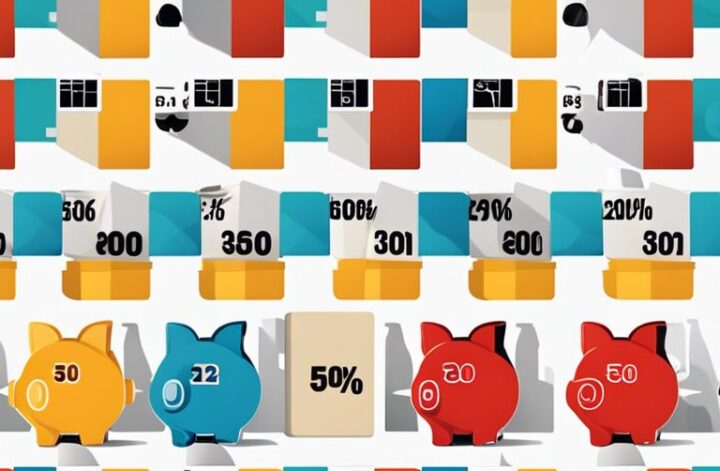Balancing various financial goals within a single budget can be a challenging task, requiring careful planning and strategic decision-making. Whether you are saving for a big purchase, tackling debt, or investing for the future, it’s vital to prioritize and allocate your resources effectively. In this blog post, we will explore strategies to help you strike a balance between short-term needs and long-term objectives, ensuring that your financial goals are aligned with your overall financial plan.
Key Takeaways:
- Evaluate Priorities: Determine your short-term and long-term financial goals, and rank them based on importance and urgency.
- Create a Realistic Budget: Allocate funds towards each goal based on your priorities, considering both the amount needed and your current income and expenses.
- Utilize Budgeting Tools: Use spreadsheets, apps, or financial planning software to track your progress towards each goal and make adjustments as needed.
- Consider Trade-Offs: Understand that balancing multiple financial goals may require making sacrifices in certain areas to achieve success in others.
- Regularly Review and Adjust: Reassess your budget and goals regularly to ensure you stay on track and make necessary changes to accommodate changes in your financial situation or priorities.
Setting Your Financial Priorities
Some financial goals may seem conflicting or overwhelming, but with careful planning and strategic budgeting, it is possible to balance them effectively. To help you navigate this process, you can refer to resources like How To Manage Multiple Financial Goals Simultaneously for additional insights and tips.
Identifying Short-Term vs. Long-Term Goals
On the journey to financial wellness, it is crucial to distinguish between short-term and long-term goals to allocate your resources efficiently. Short-term goals typically involve immediate needs or desires, such as paying off credit card debt or saving for a vacation. In contrast, long-term goals focus on substantial milestones like retirement savings or buying a home. By categorizing your goals in this way, you can prioritize them effectively and tailor your budget accordingly.
The Importance of an Emergency Fund
Your financial stability can be greatly enhanced by the presence of an emergency fund. An emergency fund is a pool of money set aside to cover unexpected expenses or financial setbacks, such as medical emergencies or sudden job loss. It is recommended to have at least three to six months’ worth of living expenses saved in your emergency fund to provide a financial cushion during uncertain times. Prioritizing the establishment and maintenance of an emergency fund is crucial to protecting your financial well-being and achieving your other financial goals confidently.

Creating a Realistic Budget
If you find yourself juggling multiple financial goals, creating a realistic budget is crucial. One useful tool to help you achieve this is the Balancing Act Budget Simulation Tool, which can assist you in visualizing and managing your financial objectives effectively.
Analyzing Income and Expenses
Any successful budget starts with a thorough analysis of your income and expenses. Take a close look at your monthly income streams, including wages, investments, and any other sources. Next, identify and categorize your monthly expenses, such as housing, transportation, utilities, and discretionary spending. Understanding these financial inflows and outflows is key to establishing a solid financial foundation.
Allocating Funds to Different Goals
Different financial goals require varying levels of funding. Prioritize your objectives by identifying short-term needs, like paying off debt or building an emergency fund, and long-term goals, such as saving for retirement or a major purchase. Allocate funds accordingly to ensure you are making progress towards each of your aspirations. With thoughtful planning and commitment, you can strike a balance between competing financial goals and set yourself on the path towards financial success.
Strategies for Short-term Goals
Despite the challenges of balancing multiple financial goals, there are practical strategies to help achieve short-term objectives. For a comprehensive approach, consider using the Balancing Act Online Budget Simulation Tool to visualize your financial priorities and make informed decisions.
Prioritizing High-Interest Debt
High-interest debt can hinder your financial progress, so it’s crucial to prioritize paying it off. Allocate a significant portion of your budget towards repaying high-interest loans or credit card balances. By focusing on reducing these debts, you can save money in the long run and improve your overall financial health.
Saving for Immediate Needs
One imperative short-term goal is building an emergency fund to cover unexpected expenses. Aim to save at least three to six months’ worth of living expenses to protect yourself from unforeseen financial crises. For instance, setting aside a portion of your income each month for emergencies can provide peace of mind and financial stability during uncertain times.
By implementing these strategies for short-term goals, you can effectively manage your finances and work towards achieving a healthy balance between your immediate needs and long-term objectives.

Strategies for Long-term Goals
Retirement Planning
Goals for retirement planning are crucial as you aim to secure your financial future. Unlike short-term goals, such as saving for a vacation, retirement planning requires a long-term perspective. It is important to have a clear understanding of your retirement goals, whether it’s retiring early, maintaining a certain standard of living, or traveling extensively during retirement.
Investing in Your Future
Planning for long-term financial goals like investing in your future is fundamental for building wealth over time. By strategically investing in assets such as stocks, bonds, and real estate, you can diversify your portfolio and potentially generate substantial returns. It is vital to assess your risk tolerance, time horizon, and investment objectives when planning for long-term goals.
Adjusting Your Budget Over Time
Many people set financial goals and create a budget, thinking they’ve done the hard work. However, it’s crucial to continuously monitor and adjust your budget over time to ensure you’re on track to achieve your goals. Life circumstances change, unexpected expenses arise, and priorities shift, making it necessary to regularly review and tweak your budget to stay on course.
Monitoring Your Progress
To effectively balance competing financial goals, you must regularly monitor your progress. Keep track of your income, expenses, and savings to ensure you’re staying within budget and making progress towards your short-term and long-term objectives. Utilize tools like budgeting apps or spreadsheets to track your financial transactions and evaluate your financial health regularly.
Making Necessary Adjustments
To maintain financial stability and progress towards your goals, be prepared to make necessary adjustments to your budget. If you notice you’re overspending in certain categories or falling short on savings targets, it may be time to reassess your spending habits and make changes accordingly. Consider reallocating funds from non-imperative expenses to prioritize your financial goals, or explore opportunities to increase your income to enhance your savings potential.
The key to successfully balancing competing financial goals within a single budget is the flexibility to adapt to changing circumstances and make informed decisions to optimize your financial resources. By consistently monitoring your progress and making necessary adjustments, you can stay on track towards achieving both your short-term and long-term financial objectives.
Tools and Resources
Budgeting Software and Apps
Nowadays, there are numerous budgeting software and apps available to assist individuals in managing their finances effectively. These tools help in tracking expenses, setting financial goals, and creating budgets that cater to both short-term and long-term objectives. Some popular options include Mint, You Need a Budget (YNAB), and Personal Capital.
Professional Financial Planning
One of the best ways to balance competing financial goals within a single budget is to seek the guidance of a professional financial planner. These experts can provide personalized advice based on your specific financial situation, helping you prioritize your goals and create a comprehensive plan to achieve them. According to a study, individuals who work with a financial planner are more likely to save for retirement and have higher levels of financial well-being compared to those who do not seek professional help.
Balancing Act in Practice
When Life Changes Your Plans
All too often, unexpected life events can throw a wrench into our carefully laid out financial plans. With competing financial goals in mind, it’s important to remain adaptable and flexible in the face of change. Whether it’s a sudden job loss, a medical emergency, or a major expense, having a buffer in your budget to cushion the blow can help you weather the storm without derailing your progress towards your goals.
Staying Motivated and Committed
For many individuals, maintaining motivation and commitment to their financial goals can be a challenge. To stay on track, it’s important to regularly review and reassess your goals, celebrating small victories along the way. Setting milestones and tracking your progress can help keep you motivated and committed to achieving both your short-term and long-term financial objectives.
Bear in mind, financial planning is a journey, not a sprint. By staying focused on your goals and making adjustments as needed, you can successfully balance competing financial goals within a single budget and pave the way towards a more secure financial future.


Final Words
So, as we wrap up our discussion on balancing competing financial goals within a single budget, it becomes evident that careful planning and prioritization are vital. It is crucial to strike a balance between short-term needs and long-term objectives to ensure financial stability and success. By establishing clear goals, creating a realistic budget, and regularly reviewing and adjusting your financial plan, you can effectively manage and achieve multiple financial goals simultaneously.
Keep in mind, financial planning is a dynamic process that requires ongoing attention and adjustment. It is vital to stay disciplined, make informed decisions, and seek professional guidance when needed. With dedication and strategic decision-making, you can successfully navigate the complexities of balancing competing financial goals and achieve financial security and success in the long run.




